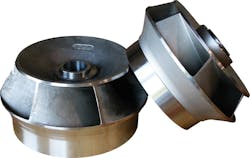When turbines are new and working at peak performances, day-to-day work is much simpler because repairing and replacing turbines is costly and takes time away from business as usual. Keep focus on the more important aspects of business by following these steps for smooth operations and extending the life span of turbines.
- Initiate a regular monitoring schedule and stick to it.
Turbines begin to wear the minute they are started, so it is vital to check them regularly. Record the flow and the pressure of a pump’s outflow the first day a new turbine is started to gauge its efficiency.- Aim for a monitoring schedule of once every three months.
- The more abrasive the application of the turbine, the more regularly it should be checked—as frequently as once a month. Depending on the application, a normal life span for turbines in a wastewater environment is three to 10 years.
- Choose stainless steel over bronze whenever possible.
Bronze is a key component for both vertical and submersible turbines. All municipal systems must include chemicals in their water systems to ensure proper safety, of which the most common is chlorine.Chlorine attacks bronze and causes early failure, shortening the overall life of the equipment. Stainless steel is a better choice in high-chlorine concentrations, saltwater applications or where there is a low pH in the water because it is resistant to the negative effects of these chemicals.
- Lost wax investment castings are superior to all other impeller castings.
Lost wax castings are injected into a stainless steel pattern, creating a perfect mold with each injection. This yields smoothness, and the smoother castings promote higher efficiency. Better efficiency means less horsepower, so energy is saved. Sand castings have core shifts, void areas and rough surfaces, which cause lower efficiencies and faster deterioration. - Strength and hardness are considered two of the most important physical properties when choosing pump impeller material because they relate directly to the ability to withstand abrasion.
Follow these guidelines:- Stainless steel impellers: Brinell hardness range of 148 to 172;
- Bronze impellers: Brinell hardness range of 60 to 159;
- Tensile strength for stainless steel: 80,000 to 135,000 psi; and
- Tensile strength for bronze: 26,000 to 85,000 psi.
- Abrasive wear, sand and water cause damage.
Abrasiveness and water are the two most significant factors that wear on turbines. Be on the lookout for tolerances opening up, which compromise stability and cause vibration that also can lead to system failure. In addition, working turbines create friction and that friction causes wear over time. - When changes occur in amperage, flow and pressure, it is time to reassess and consider turbine replacement.
A drop in turbine output is detrimental to the overall system. Sometimes a system failure can mean that a part needs to be replaced, not that the entire pump needs to be rebuilt. - When replacing a turbine, look for the following characteristics in the new equipment:
- Quick replacement;
- Availability of compatible parts for easy replacement;
- High-quality materials, which produce the most efficient system; and
- Abrasive-resistant materials for parts such as the shaft, bearings, bushings, impeller and bowl.
- When replacing a turbine, dismantle from the top down.
Reassemble from the bottom up. - During a turbine replacement, do a check for:
- Any fractures or cracks in castings;
- Damage in the column and head; and
- Any cracked or broken parts that need to be replaced.
- Improper handling of the packing is the most frequent error made by non-professional installers.
It is highly recommended to use professional, quality installers for all jobs. Packing should be loose upon startup, not tight. There should be water spray, but not on the motor. Start slowly controlling the tightening of nuts evenly on startup for proper flow to the head drain, and divert the flow back into the pit. Finally, replace packing when necessary. - Follow all safety instructions provided by the manufacturer. For instance:
- Switch pumps off before any maintenance;
- Drain out all liquids before servicing;
- Stand away from any moving parts and take necessary precautions, such as wearing rubber gloves and using insulated tools, while servicing electrical motors; and
- Keep an up-to-date record of all maintenance work.
- Hiring qualified installation professionals prevents headaches.
They should check:- Shaft alignment and coupling;
- Faceplate leveling and rigidity;
- Alignment to the discharge piping; and
- Proper setting of the rotating assembly of the impellers.
Personnel involved in day-to-day wastewater operations and management who follow these tips will see a longer turbine life and better overall performance of the turbines they monitor.
Download: Here


